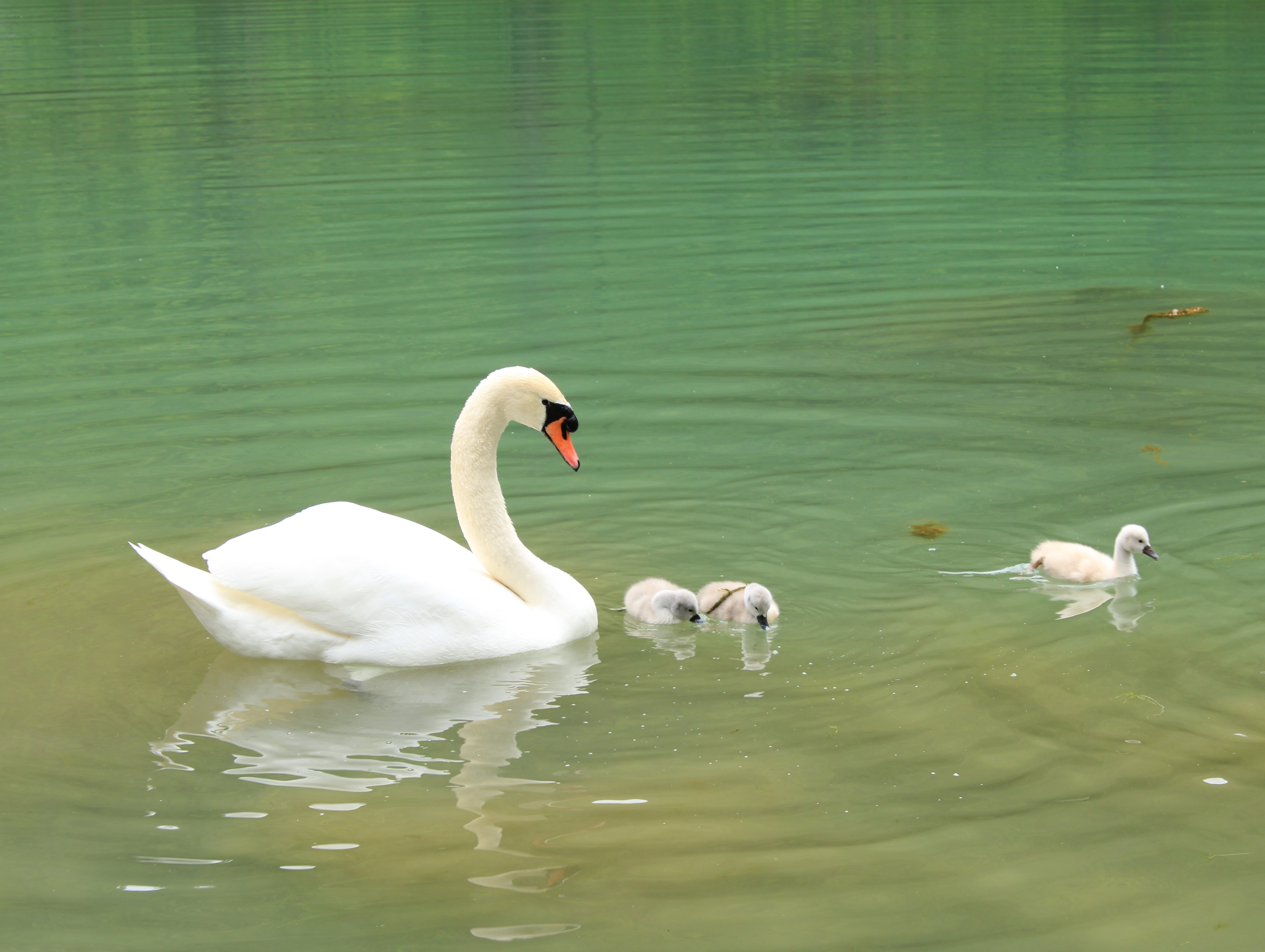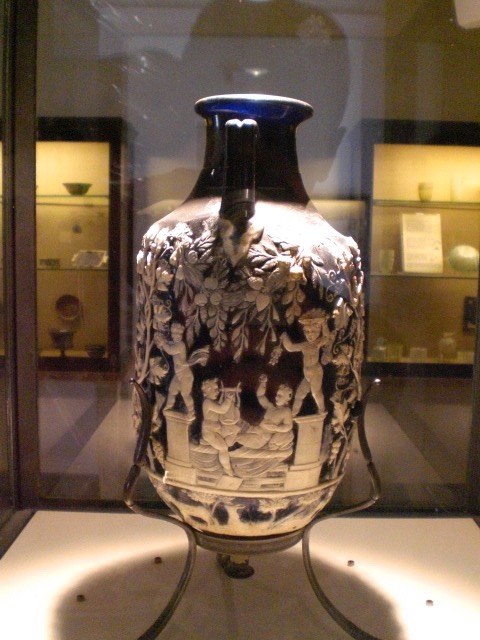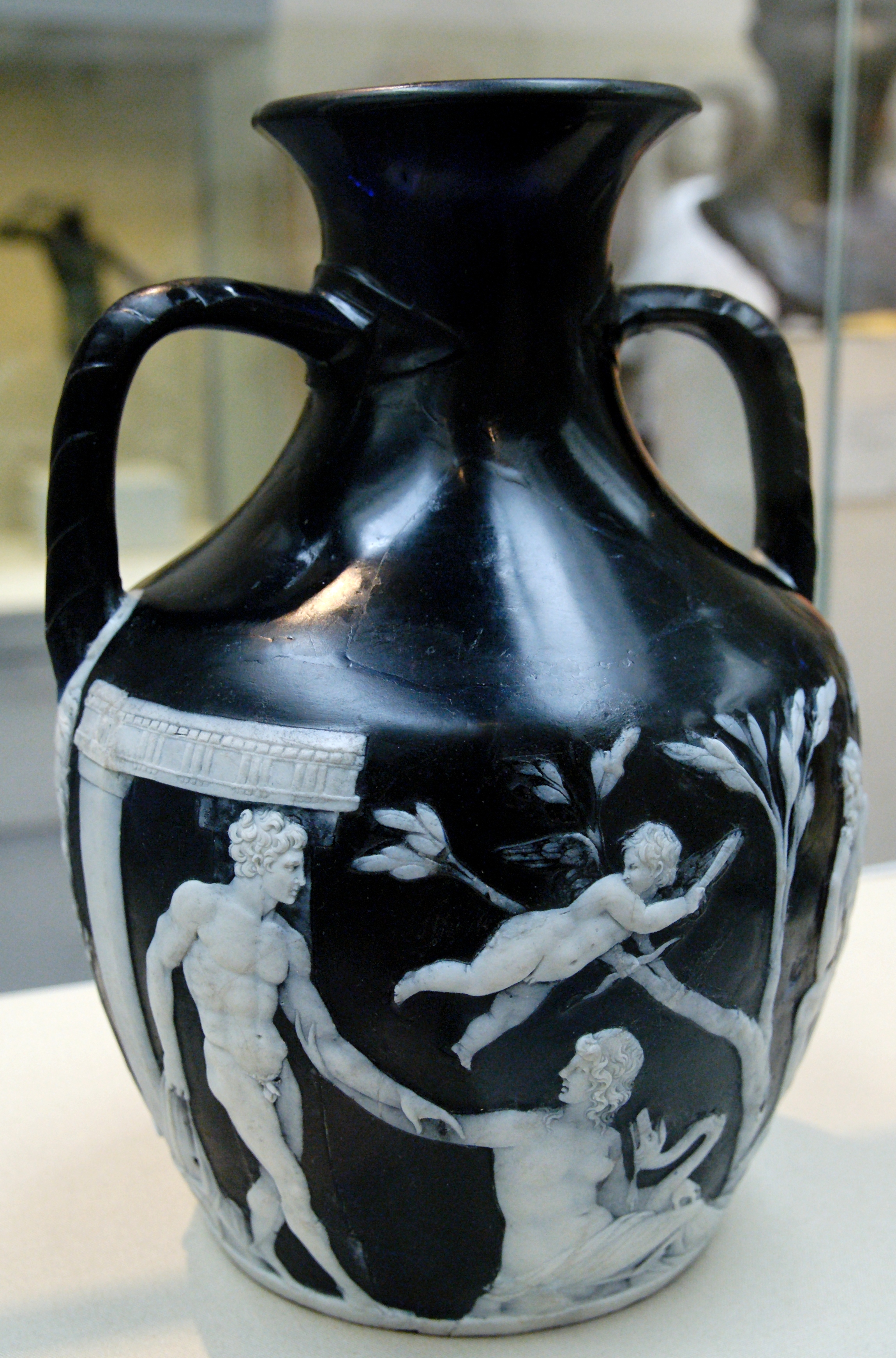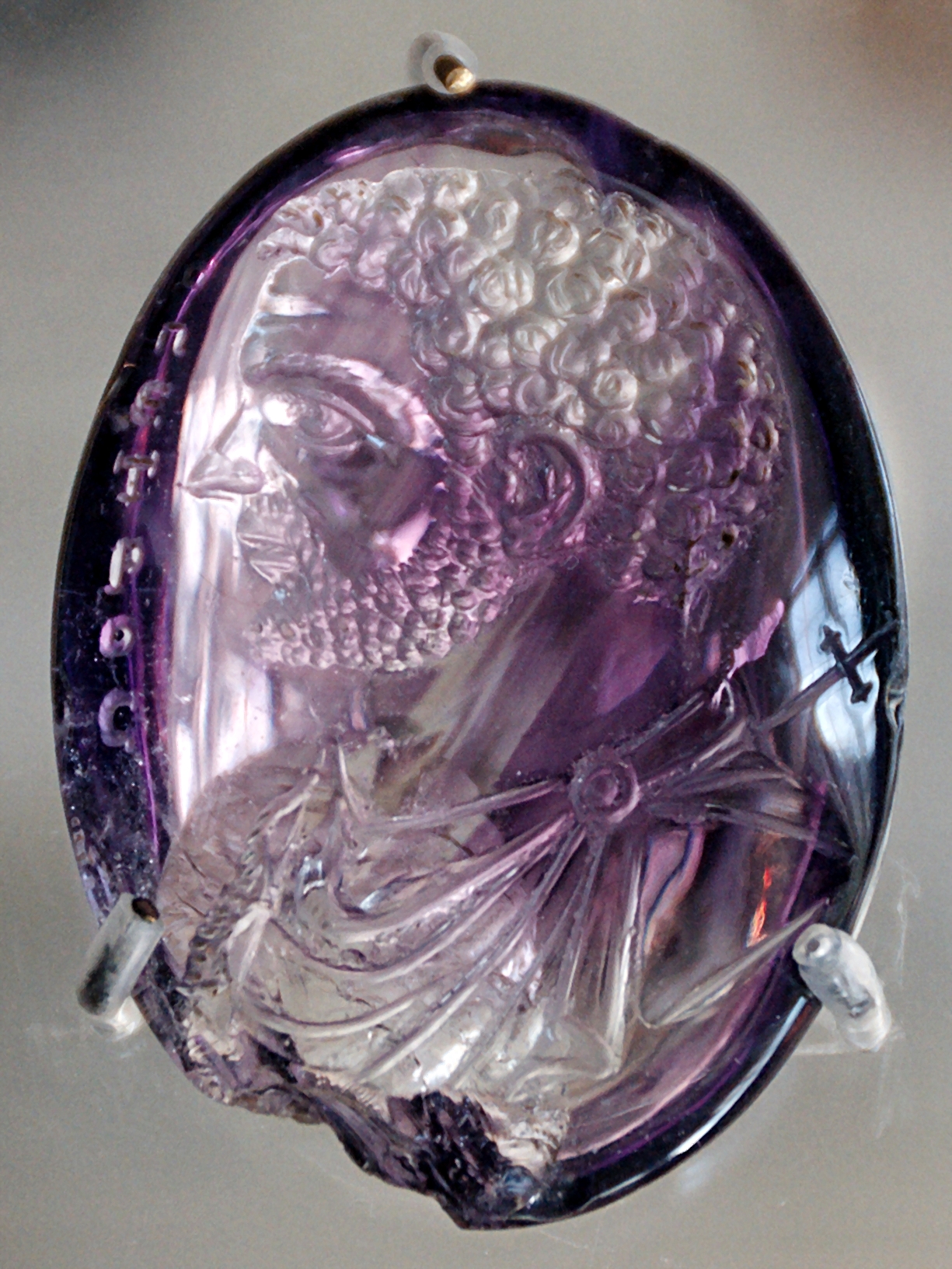|
Thomas Webb And Sons
Thomas Webb & Sons was an English glass company, founded in 1837 by Thomas Webb (1804-1869) near Stourbridge, England. The name T. Webb & Co. was adopted in 1842, and later became Thomas Webb & Sons. Webb operated the Platts glasshouse from 1837 to 1856 and then the Dennis glassworks from 1855 to 1990. The company, known originally as the "Crystal King of England," was noted for the high quality of its Cameo glass. Cameo glass is created by a process of etching and carving through a layer of opaque white glass, leaving a white relief design on a darker colored glass body. Some pieces used two layers of etched glass to create a three-color Cameo glass product. In the 1870s John Northwood produced the first pieces, inspired by the Portland Vase. George Woodall would produce the most distinguished Webb Cameo work towards the end of the 19th century. The finest and most valuable pieces were signed with "GEM CAMEO" included in the mark - Roman cameo glass was itself an imitation ... [...More Info...] [...Related Items...] OR: [Wikipedia] [Google] [Baidu] |
Swan Cameo Glass Perfume By Thomas Webb & Sons
Swans are birds of the family Anatidae within the genus ''Cygnus''. The swans' closest relatives include the geese and ducks. Swans are grouped with the closely related geese in the subfamily Anserinae where they form the tribe Cygnini. Sometimes, they are considered a distinct subfamily, Cygninae. There are six living and many extinct species of swan; in addition, there is a species known as the coscoroba swan which is no longer considered one of the true swans. Swans usually mate for life, although "divorce" sometimes occurs, particularly following nesting failure, and if a mate dies, the remaining swan will take up with another. The number of eggs in each clutch ranges from three to eight. Etymology and terminology The English word ''swan'', akin to the German , Dutch and Swedish , is derived from Indo-European root ' ('to sound, to sing'). Young swans are known as '' cygnets'' or as '' swanlings''; the former derives via Old French or (diminutive suffix et 'little') f ... [...More Info...] [...Related Items...] OR: [Wikipedia] [Google] [Baidu] |
England
England is a country that is part of the United Kingdom. It shares land borders with Wales to its west and Scotland to its north. The Irish Sea lies northwest and the Celtic Sea to the southwest. It is separated from continental Europe by the North Sea to the east and the English Channel to the south. The country covers five-eighths of the island of Great Britain, which lies in the North Atlantic, and includes over 100 smaller islands, such as the Isles of Scilly and the Isle of Wight. The area now called England was first inhabited by modern humans during the Upper Paleolithic period, but takes its name from the Angles, a Germanic tribe deriving its name from the Anglia peninsula, who settled during the 5th and 6th centuries. England became a unified state in the 10th century and has had a significant cultural and legal impact on the wider world since the Age of Discovery, which began during the 15th century. The English language, the Anglican Church, and Eng ... [...More Info...] [...Related Items...] OR: [Wikipedia] [Google] [Baidu] |
Glass
Glass is a non-Crystallinity, crystalline, often transparency and translucency, transparent, amorphous solid that has widespread practical, technological, and decorative use in, for example, window panes, tableware, and optics. Glass is most often formed by rapid cooling (quenching) of the Melting, molten form; some glasses such as volcanic glass are naturally occurring. The most familiar, and historically the oldest, types of manufactured glass are "silicate glasses" based on the chemical compound silicon dioxide, silica (silicon dioxide, or quartz), the primary constituent of sand. Soda–lime glass, containing around 70% silica, accounts for around 90% of manufactured glass. The term ''glass'', in popular usage, is often used to refer only to this type of material, although silica-free glasses often have desirable properties for applications in modern communications technology. Some objects, such as drinking glasses and glasses, eyeglasses, are so commonly made of silicate- ... [...More Info...] [...Related Items...] OR: [Wikipedia] [Google] [Baidu] |
Thomas Webb (glassmaker)
Thomas Webb (1804–1869) was an English glassmaker and the founder of Thomas Webb & Sons, makers of fine English glass and crystal. Webb entered the glass industry in 1829 when he became a partner in the Wordsley glassworks of Webb and Richardsons. Webb entered into business with his father, John Webb in 1833 at the White House glassworks prior to founding the company known as "Thomas Webb & Sons" in 1837. Webb moved to the Platts, Amblecote in 1840, then relocated to the Dennis Hall site, near the town of Stourbridge Stourbridge is a market town in the Metropolitan Borough of Dudley in the West Midlands, England, situated on the River Stour. Historically in Worcestershire, it was the centre of British glass making during the Industrial Revolution. The ..., England in 1855. Thomas Webb died in 1869 and was succeeded by his son Thomas Wilkes Webb. References * * {{DEFAULTSORT:Webb, Thomas 1804 births 1869 deaths 19th-century English businesspeople ... [...More Info...] [...Related Items...] OR: [Wikipedia] [Google] [Baidu] |
Stourbridge
Stourbridge is a market town in the Metropolitan Borough of Dudley in the West Midlands, England, situated on the River Stour. Historically in Worcestershire, it was the centre of British glass making during the Industrial Revolution. The 2011 UK census recorded the town's population as 63,298. Geography Stourbridge is about west of Birmingham. Sitting within the Metropolitan Borough of Dudley at the southwestern edge of the Black Country and West Midlands conurbation, Stourbridge includes the suburbs of Amblecote, Lye, Norton, Oldswinford, Pedmore,Stambermill, Stourton, Wollaston, Wollescote and Wordsley. Much of Stourbridge consists of residential streets interspersed with green spaces. Mary Stevens Park, opened in 1931, has a lake, a bandstand, a cafe, and a mixture of open spaces and woodland. Bordered by green belt land, Stourbridge is close to countryside with the Clent Hills to the south and southwest Staffordshire and Kinver Edge to the west. Closest ... [...More Info...] [...Related Items...] OR: [Wikipedia] [Google] [Baidu] |
Albatross Cameo Glass Perfume By Thomas Webb & Sons
Albatrosses, of the biological family Diomedeidae, are large seabirds related to the procellariids, storm petrels, and diving petrels in the order Procellariiformes (the tubenoses). They range widely in the Southern Ocean and the North Pacific. They are absent from the North Atlantic, although fossil remains show they once occurred there and occasional vagrants are found. Albatrosses are among the largest of flying birds, and species of the genus ''Diomedea'' (great albatrosses) have the longest wingspans of any extant birds, reaching up to . The albatrosses are usually regarded as falling into four genera, but disagreement exists over the number of species. Albatrosses are highly efficient in the air, using dynamic soaring and slope soaring to cover great distances with little exertion. They feed on squid, fish, and krill by either scavenging, surface seizing, or diving. Albatrosses are colonial, nesting for the most part on remote oceanic islands, often with several specie ... [...More Info...] [...Related Items...] OR: [Wikipedia] [Google] [Baidu] |
Cameo Glass
Cameo glass is a luxury form of glass art produced by cameo glass engraving or etching and carving through fused layers of differently colored glass to produce designs, usually with white opaque glass figures and motifs on a dark-colored background. The technique is first seen in ancient Roman art of about 30 BC, where it was an alternative to the more luxurious engraved gem vessels in cameo style that used naturally layered semi-precious gemstones such as onyx and agate. Glass allowed consistent and predictable colored layers, even for round objects. From the mid-19th century there was a revival of cameo glass, suited equally to Neo-Grec taste and the French Art Nouveau practiced by Émile Gallé. Cameo glass is still produced today. Roman glass Roman cameo glass is fragile, and thus extremely rare—much more so than natural gemstone cameos such as the Gemma Augustea and Gonzaga Cameo, which are among the largest examples of many hundreds (at least) of surviving clas ... [...More Info...] [...Related Items...] OR: [Wikipedia] [Google] [Baidu] |
Etching
Etching is traditionally the process of using strong acid or mordant to cut into the unprotected parts of a metal surface to create a design in intaglio (incised) in the metal. In modern manufacturing, other chemicals may be used on other types of material. As a method of printmaking, it is, along with engraving, the most important technique for old master prints, and remains in wide use today. In a number of modern variants such as microfabrication etching and photochemical milling it is a crucial technique in much modern technology, including circuit boards. In traditional pure etching, a metal plate (usually of copper, zinc or steel) is covered with a waxy ground which is resistant to acid. The artist then scratches off the ground with a pointed etching needle where the artist wants a line to appear in the finished piece, exposing the bare metal. The échoppe, a tool with a slanted oval section, is also used for "swelling" lines. The plate is then dipped in a bath of ac ... [...More Info...] [...Related Items...] OR: [Wikipedia] [Google] [Baidu] |
Portland Vase
The Portland Vase is a Roman cameo glass vase, which is dated to between AD 1 and AD 25, though low BC dates have some scholarly support. It is the best known piece of Roman cameo glass and has served as an inspiration to many glass and porcelain makers from about the beginning of the 18th century onwards. It is first recorded in Rome in 1600–1601, and since 1810 has been in the British Museum in London. It was bought by the museum in 1945 (GR 1945,0927.1) and is normally on display in Room 70. The vase measures about high and . It is made of violet-blue glass, and surrounded with a single continuous white glass cameo making two distinct scenes, depicting seven human figures, plus a large snake, and two bearded and horned heads below the handles, marking the break between the scenes. The bottom of the vase was a cameo glass disc, also in blue and white, showing a head, presumed to be of Paris or Priam on the basis of the Phrygian cap it wears. This roundel clearly does not ... [...More Info...] [...Related Items...] OR: [Wikipedia] [Google] [Baidu] |
Engraved Gem
An engraved gem, frequently referred to as an intaglio, is a small and usually semi-precious gemstone that has been carved, in the Western tradition normally with images or inscriptions only on one face. The engraving of gemstones was a major luxury art form in the Ancient world, and an important one in some later periods. Strictly speaking, ''engraving'' means carving ''in intaglio'' (with the design cut ''into'' the flat background of the stone), but relief carvings (with the design projecting ''out of'' the background as in nearly all cameos) are also covered by the term. This article uses ''cameo'' in its strict sense, to denote a carving exploiting layers of differently coloured stone. The activity is also called ''gem carving'' and the artists ''gem-cutters''. References to antique gems and intaglios in a jewellery context will almost always mean carved gems; when referring to monumental sculpture, counter-relief, meaning the same as ''intaglio'', is more likely to be ... [...More Info...] [...Related Items...] OR: [Wikipedia] [Google] [Baidu] |
Exposition Universelle (1889)
The Exposition Universelle of 1889 () was a world's fair held in Paris, France, from 5 May to 31 October 1889. It was the fourth of eight expositions held in the city between 1855 and 1937. It attracted more than thirty-two million visitors. The most famous structure created for the Exposition, and still remaining, is the Eiffel Tower. Organization The Exposition was held to celebrate the 100th anniversary of the Storming of the Bastille, which marked the beginning of French Revolution, and was also seen as a way to stimulate the economy and pull France out of an economic recession. The Exposition attracted 61,722 official exhibitors, of whom twenty-five thousand were from outside of France. Admission price Admission to the Exposition cost forty centimes, at a time when the price of an "economy" plate of meat and vegetables in a Paris cafe was ten centimes. Visitors paid an additional price for several of the Exposition's most popular attractions. Climbing the Eiffel To ... [...More Info...] [...Related Items...] OR: [Wikipedia] [Google] [Baidu] |
Tiffany & Co
Tiffany & Co. (colloquially known as Tiffany's) is a high-end luxury jewelry and specialty retailer, headquartered on Fifth Avenue in Manhattan. It sells jewelry, sterling silver, porcelain, crystal, stationery, fragrances, water bottles, watches, personal accessories, and leather goods. Tiffany is known for its luxury goods, particularly its diamond and sterling silver jewelry. These goods are sold at Tiffany stores, online, and corporate merchandising. Its name and branding are licensed to Coty for fragrances and to Luxottica for eyewear. Tiffany & Co. was founded in 1837 by the jeweler Charles Lewis Tiffany and became famous in the early 20th century under the artistic direction of his son Louis Comfort Tiffany. In 2018 net sales totaled US$4.44 billion. In 2019 Tiffany operated 326 stores globally in countries such as the United States, Japan, and Canada, as well as Europe, the Latin America and Pacific Asia regions. On January 7, 2021, French multinational LVMH M ... [...More Info...] [...Related Items...] OR: [Wikipedia] [Google] [Baidu] |











